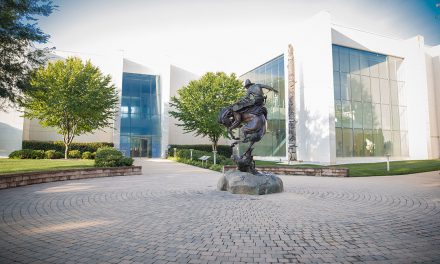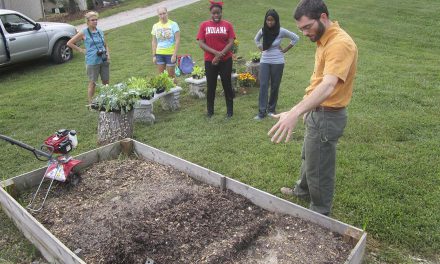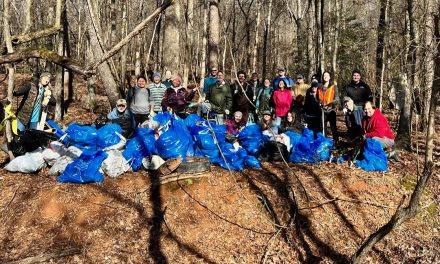With centuries of unrest and turmoil behind them, Albania and North Macedonia thrive
In September, Lakeside News Senior Writer Pam Keene continued her international treks. On her most recent Overseas Adventure Travels trip, she and fellow travelers journeyed to Northern Greece, Albania and North Macedonia, through mountain terrain, seaside towns, ancient ruins and modern cities to learn about this little-known part of the planet.
In the second part of her journey, she finds surprises and political revelations, discovering how Albania and North Macedonia survived communist rule to become two of the newest frontiers of tourism in the Balkans.
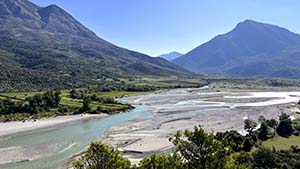
The Vjosa River upstream from the municipality of Tepelenë is known for its flavorful mineral water, which is bottled at a plant in town.
As our group of 14 made its way from Northern Greece into Albania and North Macedonia, the next week of travel yielded dark times and a bright future. For centuries the two present-day countries were unstable, battling with the Greeks, the Romans, the Byzantine Empire and the Ottoman Empire. There were fierce battles for possession of these, and other, Balkan lands, eventually leaving a hodge-podge of incredible history with plenty of physical evidence, scattered around the countryside and in the cities.
We didn’t know what to expect in Albania, but my first thoughts prepared me to expect a battle-torn land similar to the condition of Palestine when I was there five years ago. Not so.
What a surprise to find Gjirokaster, one of the largest towns, nestled in a valley with a quaint collection of stone-paved pedestrian streets lined with shops of the town’s bazaar. Our hotel was very modern and comfortable, perfectly located at the lower end of the bazaar, and easy walking distance to historic sites.
The town is making continued improvements to welcome travelers from around the world. Many of the merchants and restauranteurs spoke some English, making it easier for those of us who – erroneously – expect everyone to speak our language.
Here, there is freedom of religion, with Eastern Orthodoxy, Greek Catholicism, Islam and Protestant. Throughout our journey, we visited worship centers for each.
A Day in the Life program, a trademark of Overseas Adventure Travel, took us to a small village about an hour’s drive from Gjirokaster. We walked through the village, meeting some of its long-time citizens and spending most of the day at a farm. Landi and his family have lived in the village for generations. Their large farm includes a large apiary/bee yard, almond trees, a vineyard and a place where they make snacks to sell around the country.
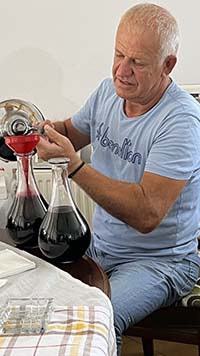
Landi decants red wine crafted at his farm in Dhoksat.
We helped prepare a delicious fresh lunch made from produce grown on the farm accompanied by Landi’s hand-crafted red wine. Under a shady arbor, we overlooked the hillsides and learned about his family’s history, shared conversation and the relaxation of rural life.
The following day we visited the ancient ruins at Butrint, a UNESCO World heritage Site, that includes Greek, Roman and Byzantine structures. Abandoned in the Middle Ages, its stone structures – fortifications, an amphitheater and remains – are well-preserved.
Lunch at nearby Saranda on the Ionian Sea provided stunning views of the turquoise-blue waters and a backdrop of some of the Greek Islands. Because the weather was still warm, the white-sand beaches were filled with tourists from across Europe and the Balkans, enjoying one last holiday.
On our way to the Albanian capital of Tirana, we visited another UNESCO site, Berat Castle. A 13th century fortress with 24 watch towers, inside there are ancient homes, museums and restaurants, as well as several churches and a museum of Medieval art.
The modern – and constantly expanding – Albanian capital of Tirana greeted us with a mix of buildings from the Communist era, tall modern and sleek structures and scaffolding. Since becoming free of Communism in 1991, the capital has stretched its wings to modernize.
From roaming through Tirana’s Old Town and its bazaar of fruits, and vegetables, to visiting the National History Museum with its comprehensive exhibits of the country’s turbulent history before WWII, we felt a sense of the resilience of the people. Skanderbeg Square in the center of the city stays abuzz with activity from the early mornings until late at night.
While we were there the Albanian football team (soccer to Americans) soundly defeated Poland in the UEFA European Championship Qualifying Game. Rousing celebrations could be heard that night around the city.
Albania has a dark past. From the 1960s to the 1980s, the country was ruled by the Communist/Stalinist leader Enver Hoxha. During his time, he attempted to fortify the country by building more than 750,000 domed-shaped bunkers throughout Albania. To protect himself and his leadership he ordered the construction of a super-bunker, a communist-era nuclear bomb shelter.
Not just you’re average bunker, the structure was five stories deep underground with narrow corridors, an assembly hall and more than 100 rooms, including Hoxha’s private quarters. Today, it’s an art museum, now called Bunk’Art, that features art installations.
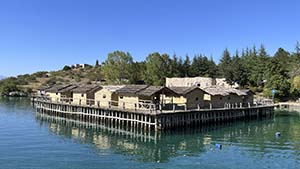
Lake Ohrid’s Bay of Bones showcases a reconstruction of an ancient village on stilts from the Bronze and Iron Ages.
Next stop: North Macedonia and Lake Ohrid. One of the Balkans’ most popular destinations, the lake covers 138 square miles and borders both Albania and North Macedonia. We stayed on the North Macedonian side.
The picturesque fishing town and the lake it borders on contain many treasures. A half-day boat excursion took us to the Bay of Bones, a reconstructed settlement from the Bronze and Iron ages, 1200 to 700 BC. Named because of the human and animal bones and pottery found in the late 1990s, it’s a museum and a collection of 24 houses built on a stilted platform in the mud-and-straw materials the archeologists imagined it would have looked 26 or more centuries ago.
As we walked the town, we visited early churches and a well-preserved amphitheater from 200 BC. It’s still used for concerts and musicians from around the world come here to perform.
Two more stops awaited as we journeyed toward North Macedonia’s capital of Skopje. The Painted Mosque of Tetovo, and a tour of Matka Canyon. A departure from the traditional mosque, the interior walls and ceilings are covered with bright geometric designs. A bit farther we hiked beside the Treska River, dammed in 1938 to create the only artificial lake in the country. A boat ride on the lake above the dam provided stunning views.
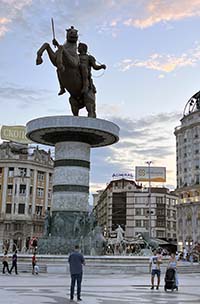
A towering statue, “Warrior on a Horse,” dominates the central square in Northern Macedonia’s capital city of Skopje.
On the last leg of our adventure, our Trip Leader Ilias reminded us about the title of our journey: “Ancient Lands of Alexander the Great.” He brought us full circle from Thessaloniki to North Macedonia through the travels of Alexander the Great.
As the Balkan countries sorted out borders and in some cases took new names, the region of Macedonia originally described a large section of the Balkans. Today, the region includes parts of six Balkan countries, including Greece, North Macedonia, Albania, Bulgaria, Serbia and Kosovo.
After independence from the communist government in 1991, the area now known as North Macedonia claimed the name The Republic of Macedonia. They also claimed to be the official country of Alexander the Great.
Over the decades, the governments of Greece and Macedonia argued over the right to be called Macedonia. Greece has maintained a region of Macedonia from ancient times.
The conflict included the Macedonians erecting several statues in its capital: A very large sculpture of “A Warrior on a Horse,” originally called “Alexander the Great,” and a beautiful fountain topped by a statue of King Phillip II, Alexander’s father, and four lower sculptures of his mother Olympia cradling the young Alexander at various stages of his life.
To settle the dispute, Macedonia officially changed its name to North Macedonia in 2019, but the back-and-forth about who “owns” the origins of Alexander the Great is still a point of conversation in certain circles.
Visits to the city’s winding streets of the Old Bazaar, reminiscent of an earlier time but still teeming with merchants selling rugs, gold, and gastronomic delicacies, alongside contemporary goods including shoes, clothing and electronics.
As our adventure drew to a close our traditional “Farewell Dinner” provided one last chance to enjoy Greek, Albanian and North Macedonian cuisine, served – as always – in generous portions. The backdrop of traditional and contemporary music filled out the evening as we reminisced about our best moments and shared memories that would keep each other and this amazing exploration in our minds for a long time to come.
Some of us are staying in touch and plan to travel together again. The biggest question is where and when? The world is filled with all kinds of people with many stories to tell and the only way to learn about them is to go, go, go. In all my adventures, I never have a favorite trip; each one holds its own magic and discovery.
Photos: by Pamela A. Keene


